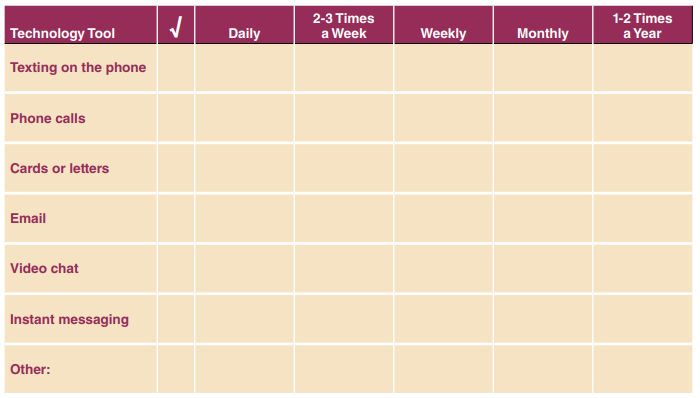AARP Report. (2012). Insights and spending habits of modern grandparents. Washington, D.C.: AARP Research and Strategic Analysis. Retrieved from: www.aarp.org/content/dam/aarp/research/surveys_statistics/general/2012/Insights-and-Spending-Habits-of-Modern-Grandparents-AARP.pdf
AARP Research. (2017). Technology use and attitudes among mid-life and older Americans. Washington, D.C.: AARP Research. Retrieved from: www.aarp.org/content/dam/aarp/research/surveys_statistics/technology/info-2018/atom-nov-2017-tech-module
Bangerter, L.R., and Waldron, V.R. (2014). Turning points in long distance grandparent-grandchild relationships. Journal of Aging Studies, 29, 88-97.
Harrington Meyer, M., and Kandic, A. (2017). Grandparenting in the United States. Innovation in Aging, 1(2), 1-10. doi:10.1093/geroni/igx023
Hayslip, B., Maiden, R.J., and Dolbin-MacNab, M.L. (2015). Relationships between grandparents and their grandchildren: An applied dyadic perspective. In Kirkcaldy, B. (Ed.), Promoting Psychological Well-Being in Children and Families (pp. 279-295). London: Palgrave Macmillan.
Pew Research Center. (2019). Millennials stand out for their technology use, but older generations also embrace digital life. Retrieved from www.pewresearch.org/fact-tank/2019/09/09/us-generations-technology-use/
Wasserman, S. (2010). Grandparenting at long distance: Connecting with grandchildren across the miles. Brush Education.
For more in The Art of Grandparenting series, please visit www.ag.ndsu.edu/familyscience
The NDSU Extension Service does not endorse commercial products or companies even though reference may be made to tradenames, trademarks or service names.
NDSU encourages you to use and share this content, but please do so under the conditions of our Creative Commons license. You may copy, distribute, transmit and adapt this work as long as you give full attribution, don’t use the work for commercial purposes and share your resulting work similarly. For more information, visit www.ag.ndsu.edu/agcomm/creative-commons.
For more information on this and other topics, see www.ag.ndsu.edu
County commissions, North Dakota State University and U.S. Department of Agriculture cooperating. NDSU does not discriminate in its programs and activities on the basis of age, color, gender expression/identity, genetic information, marital status, national origin, participation in lawful off-campus activity, physical or mental disability, pregnancy, public assistance status, race, religion, sex, sexual orientation, spousal relationship to current employee, or veteran status, as applicable. Direct inquiries to Vice Provost for Title IX/ADA Coordinator, Old Main 201, NDSU Main Campus, 701-231-7708, ndsu.eoaa@ndsu.edu. This publication will be made available in alternative formats for people with disabilities upon request, 701-231-7881. 600-9-20
